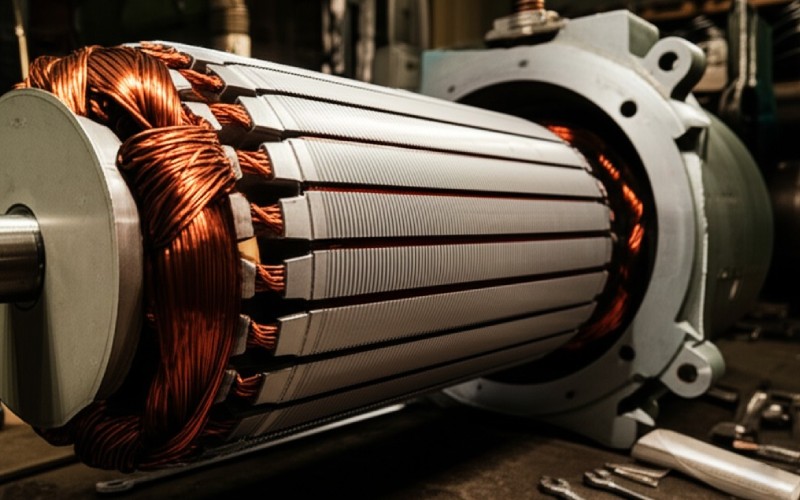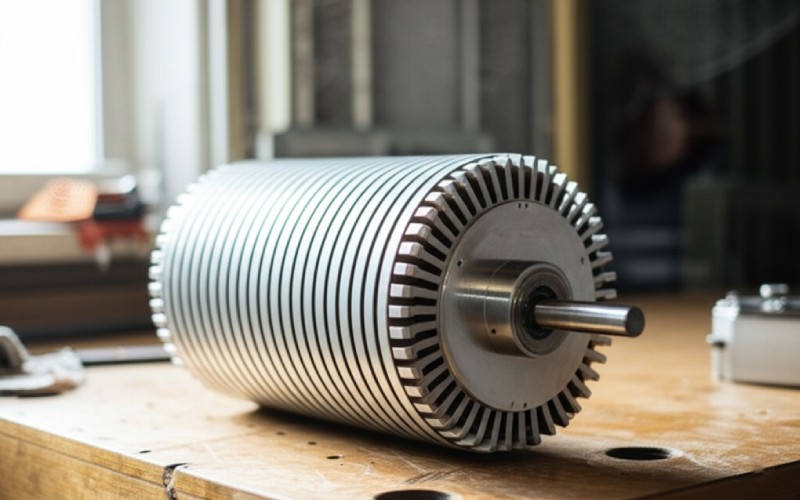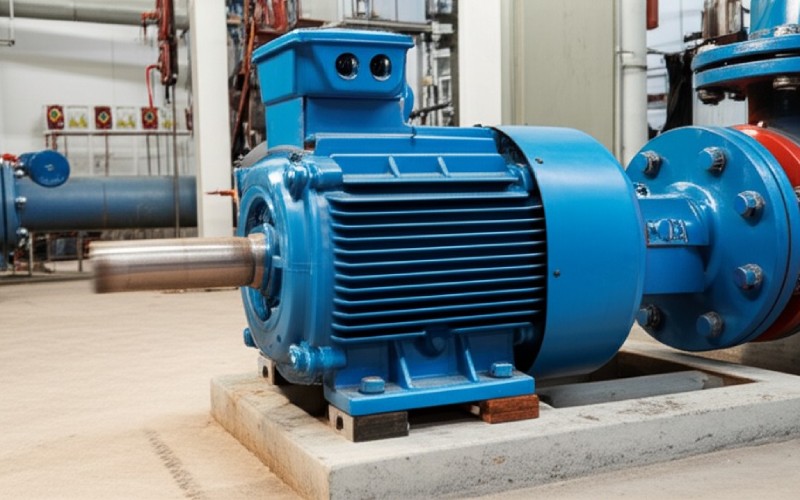Let Sino's Lamination Stacks Empower Your Project!
To speed up your project, you can label Lamination Stacks with details such as tolerance, material, surface finish, whether or not oxidized insulation is required, quantity, and more.

Inside most of electric motors is a part that is simple but very clever. It’s called the squirrel-cage rotor. It looks a bit like a hamster wheel, but it is the reason the motor turns. In this article, we will look at the rotor bar, the key piece of this puzzle. I will explain in simple words how this squirrel cage rotor works. You will learn why it is so important and how its design changes the motor performance. If you want to understand what makes your motor run, this article is for you.
Inside, there is a part that looks like a cage for a small animal. That’s where the name comes from. This part is the rotor. A squirrel cage rotor is a cylinder of steel laminations. A lamination is a thin slice of steel. Many slices are stacked together to form the core of the rotor. This design helps reduce energy losses. Running through this core are many bars, called rotor bars. These rotor bars are connected at each end by an end ring. The bars and the rings together look like a squirrel cage. This simple cage is what makes the whole motor turn.
The entire assembly of rotor bars and end rings is very strong. This is a very rugged design. The bars are not insulated from the iron core. This is because the current will naturally follow the path of the bars. The bars have better conductivity. This whole part, the squirrel cage rotor, is a key piece of many electric motors. There is no electrical connection to this rotor from the outside. That’s what makes the squirrel cage motor so reliable. The basic design of this rotor is pure genius.
So, how does this motor start to spin? It’s all about a cool trick with magnets. The outside part of the motor is called the stator. When you apply power to the stator, an alternating current flows through its winding. This current in the stator winding creates a rotating magnetic field. Think of it like a magnet that is spinning very fast. This magnetic field is the key. The motor works like a transformer in some ways.
This spinning magnetic field from the stator cuts across the rotor bars of the squirrel cage rotor. Remember, the rotor is not moving yet. When a magnetic field moves past a metal bar, it makes electricity flow in the bar. We say it will induce a current. So, a voltage and a current are created in each rotor bar. Because the rotor bars are connected by the end ring at each end, the current can flow in a closed path, or a rotor circuit. This is a very important step for the induction motor. The magic happens when power is applied to the stator.

The rotor bar is the true hero inside a squirrel cage motor. Each rotor bar acts as a conductor. When the magnetic field from the stator moves past the rotor, it creates, or induces, a current in the rotor bar. Now we have a bar with current flowing through it, sitting inside another magnetic field. This is where the force comes from. The interaction between the magnetic field and the current in the rotor bar creates a force that pushes the bar.
This push on every single rotor bar adds up. This combined push creates a twisting force, which we call torque. It is this torque that makes the rotor start to spin. Without the rotor bar, no current would flow in the rotor, and no torque would be made. The motor would just sit there and hum. So you see, the humble rotor bar is the part that turns electrical energy into motion for the motor. The design of the rotor bar helps decide how much starting torque the motor will have. A good squirrel cage design is vital for a good motor.
Rotor bars are made from different materials. The most common are aluminum or copper. The choice of material is very important for motor performance. Aluminum or copper are used because they are a good conductor of electricity. This property is called conductivity. Copper has better conductivity than aluminum. This means a motor with copper bars is often more efficient. It wastes less energy as heat.
However, aluminum is cheaper and lighter. Many motors use die-cast aluminum. In this process, melted aluminum is forced into the slots in the rotor lamination stack to form the rotor bars and end rings all at once. This makes the squirrel cage strong and not very expensive. High-efficiency motors, which are set by standards like NEMA and IEC, often use copper for their rotor bar construction. A motor with a copper squirrel cage rotor can have lower energy losses. So the choice of material for the rotor bar is a balance between cost and the motor’s efficiency. Some special motors might even use a brass alloy.
Let’s talk more about torque. The torque produced by the motor is what does the work. A current is induced in the rotor bars. This is called the induced current. This current creates its own small magnetic fields around each rotor bar. These small magnetic fields push against the big rotating magnetic field from the stator. This pushing and pulling is what creates the torque to turn the shaft. It’s a bit like how two magnets can push each other apart.
The amount of torque depends on a few things. It depends on the strength of the stator field. It also depends on the amount of current in the rotor. The goal of a good motor design is to have high torque. The profile of the rotor bars can be shaped to change the speed-torque characteristics. For example, some designs use a deep, narrow rotor bar. This helps increase the motor starting torque. This is useful for motors that need to start with a heavy load. The torque is what makes the motor go from zero to full speed.
It sounds strange, but it is very important for a squirrel cage induction motor. Remember the rotating magnetic field in the stator? It spins at a fixed speed. We call this the synchronous speed. For the rotor to have a current induced in it, it must spin slower than the magnetic field. If the rotor spun at the same speed, the rotor bars would be standing still relative to the field. No current would be induced, and there would be no torque.
This difference in speed between the stator field and the rotor is called slip. Slip is what allows the motor to work. When the motor has no load, the slip is very small. The rotor turns at a speed very close to the synchronous speed. When you put a full load on the motor, the rotor slows down a bit. This increases the slip. A bigger slip means the magnetic field cuts the rotor bars faster. This will induce a larger current, which creates more torque to handle the load. So, slip is necessary. The slip frequency is related to how much torque produced there is.
Have you ever looked closely at a squirrel cage rotor? You might notice that the rotor bar slots are not parallel to the shaft of the rotor. They are slightly angled. This is called skew. There are good reasons for this. First, the skew helps the motor run more smoothly and quietly. It helps to reduce the noise produced by the motor. It also stops something called magnetic locking, where the rotor and stator teeth can line up and prevent the motor from starting.
Another big reason for skew is to improve the performance of the motor. The skew of the rotor bar helps to produce a more uniform torque as the rotor turns. This makes the motor operation smoother. The skew also helps to reduce certain unwanted electrical effects. The length of the rotor bar is slightly increased by the skew, which changes its resistance. The amount of skew is a careful design choice. It is based on the number of stator slots and the number of rotor bars to get the best motor performance.
Yes, a broken rotor bar can cause big problems for a motor. The squirrel cage is a closed circuit. If a rotor bar cracks or breaks, that circuit is now open. This is bad for the balance of the rotor. A broken rotor bar means less current can flow, which leads to less torque. The motor will lose power. You might hear a strange noise, or the motor might vibrate more than usual. This can cause extra stress on the bearings and the whole motor.
A broken rotor bar can also make the motor overheat. The current that would have gone through the broken bar now has to go through the other bars. This can overload them. This is a common failure in a squirrel cage induction motor. It can be caused by the motor starting and stopping too often, or by a problem during manufacturing. If you think you have a broken rotor bar, it’s important to get the motor checked. Misalignment of the stator and rotor can also cause issues. The health of every rotor bar is important for the health of the entire motor.
The design of the cage rotor has a huge impact on how a motor works. Engineers can change many things about the squirrel cage to get the performance they want. For example, the shape of the rotor bar matters a lot. A deep bar has different properties from a round bar. Deep bars can be used to maximize low-speed torque. This is because of something called the skin effect. At the start, current flows near the top of the bar. As the motor accelerates, the current uses the whole bar. This design gives good starting torque but also good running efficiency.
The material of the rotor bar also matters. Using copper instead of aluminum changes the resistivity of the rotor winding. Lower resistance usually means a more efficient motor but may lower the starting torque. The number of rotor bars and their angle of skew are also important design choices. All these factors affect the speed-torque characteristics, the starting current, the power factor, and the overall efficiency of the squirrel cage induction motor. The design of a simple-looking cage rotor is actually very complex.

Yes, the squirrel cage induction motor is one type of motor, but there are others. One common alternative is the wound rotor motor. The biggest difference is in the rotor. As we know, the squirrel cage rotor has conductive bars that are shorted at the ends by shorting rings. The rotor winding is fixed. You cannot change it. This makes the squirrel cage induction design very simple and reliable.
A wound rotor motor has a more complex rotor. Instead of bars, it has a full three-phase winding, much like the stator winding. The ends of this rotor winding are brought out to slip rings on the shaft. This lets you connect external resistors to the rotor circuit. By changing the resistance, you can control the speed-torque characteristics of the motor. This gives more control, especially for starting. But, it makes the motor more expensive and less rugged than a squirrel cage motor. For most jobs, the simple and tough squirrel cage motor is the best choice.